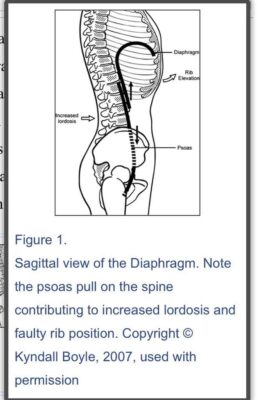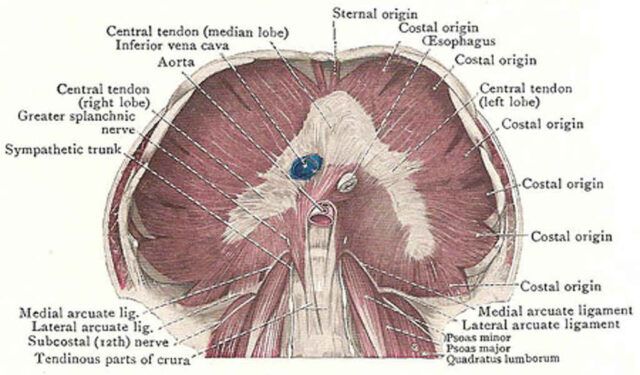StudioVeena.com › Forums › Discussions › The diaphragm and its role in…everything
-
The diaphragm and its role in…everything
Posted by Lucca Valentine on April 17, 2015 at 6:23 pmIf anyone wants to read a really long article/study on the importance of the diaphragm and how to make it more efficient here this: http://www.ncbi.nlm.nih.gov/pmc/articles/PMC2971640/
Really interesting and makes SO much sense. And as some of yall know I have a diaphragm/psoas obsession and I’m pleased to have found a perfect and simple illustration of the connection while going through the study. Visual aids are the best.
Veena replied 9 years, 11 months ago 5 Members · 8 Replies -
8 Replies
-
I tried to read the article, because I was interested.
But I will be honest- I was lost with the medical term.
I have always been interested in things that will improve my health. If you could go into this helping me to understand it alittle better I would appreciate it. exsample: breathe deep with top part of abdominals( insert correct muscle name)
something to that effect. Thank you so much. -
I guess I am not understanding how to make air go in both top and bottom directions at the same time. I know that makes me sound rather stupid lol.
-
No, not at all! It’s a weird movement/feeling/kinda complicated and really easy to confuse. It’s like a patting your head rubbing your belly situation. I’ve got some school commitments and a test due at midnight, but I am more than happy to post something that’s easier to digest and will do so as soon as I can! Postural Restoration Integration does the balloon exercises, so if you google that you may be able to find some helpful videos or articles that aren’t so jargon-y
-
Thank you so much Lucca! I will google that.
I appreciate you getting back with me so quickly. -
Absolutely! Ok so the biggest thing I took away from this article is that no matter how much you try and correct every body related funkiness (old injuries, pain built up from chronic stress, or inefficient movement patterns, etc), there is only so much you can do if you don’t train your breathing also. The diaphragm not only helps you get oxygen efficiently, but it also is one of your major abdominal stabilizers muscles.
For clarity’s sake, the diaphragm is a muscle that essentially splits your body in top and bottom portions. I believe its actually the biggest muscle in our body but don’t quote me on that, that may be yoga science. Either way, its up there. An unless you are perusing very specific anatomy books, you rarely see an image of the diaphragm from anything but the front or sides. If you were to lie on the ground and look up and see someones diaphragm, it would look like a large flexible disc stretched across the bottom of their rib cage. When its relaxed (during exhalation) it looks a like the dome we’re used to seeing in most anatomy drawings, but when you inhale it moves more towards the flat disc shape. The point of all this is to say that it is a very three dimensional muscle.
Now, this article contends that for the most part everyone breathes pretty inefficiently, for a lot of different reasons. If you sit slumped at a desk all day or driving a car: your diaphragm is squished. We are taught that having any kind of a “belly” is a bad thing, but if we were to truly diaphragmatically breath, we would all have a little bit of a belly. The reason statues of Buddha have little bellies is not because he was fat, it was because he was breathing in a relaxed, meditative state. (Anyone feel free to correct me if I’m wrong, just going off of what I”ve been told on that…haven’t fact checked or anything). As a result we get into a state of “holding” our breath to various extents, and the article attaches 2 exercises to help learn how to better control your diaphragm.
The 90/90 bridge with balloon exercise seems to be pretty readily available on youtube, but I haven’t tried it out. There is also a Kundalini breathing exercise called Breath of Fire that is excellent (but not mentioned in the article) https://www.youtube.com/watch?v=1gpYEvALCZA
As far as breathing in two places at once and that being confusing, the main idea is to not go to overboard in either direction I think. Like, you can be totally not breathing with your diaphragm and your stomach goes up. Chances are, you can do that while you’re holding your breath. So if the only thing you’re focusing on when breathing is “belly breath,” you might just be focusing on moving your stomach youre not actually properly engaging your diaphragm. It seems like that is part of what the balloon exercise is seeking to remedy. Fool proof strengthening of the diaphragm. Balloons are definitely on my shopping list now 😉
In the mean time, if you are interested, here is an exercise that was immensely helpful to me and is probably a good starting place for getting in touch with your diaphragm (it was originally taught as a relaxation exercise in tandem with a form of chiropractics)
*Lie on your back on the floor (you can put a yoga mat down or something but whatever you are on should be firm, not like a bed or a couch)
*Bring knees into your chest and make a little ball. Take a couple of breaths and let your back sink into the ground. Then place your feet flat on the floor, knees bent. This bend allows your low back to remain in contact with the ground in a healthful way
* Breathe in through your nose and out through your mouth
* Place your hands on your belly and breath into your hands. By which, I mean breath DIRECTLY into your hands, do not let the breath puff out at your chest, or ribs, direct your breath to that spot you are holding. Then relax on the exhale (through the mouth) and really allow all of your air to be exhaled from that spot you breathed into. Repeat for five cycles.
*Move your hands to your rib cage area, about where your diaphragm is actually, kind of right below where the band of your bra would be. And breathe DIRECTLY into that spot in the same way you did at your belly for about 5 times, then move your hands to your chest and repeat in the same way of breathing DIRECTLY into that sport 5 times. And you can sort of cycle through those three places, just filling and emptying them with breath and seeing which places feel stiffer than others.When you’re finished, just place your hands by your sides and allow the breath to come in naturally and observe any changes. Maybe it feels like a wave of breath moving through the areas you just worked on, maybe you feel overall relaxed, maybe you don’t feel any different! Who knows 🙂 but it really teaches you how to control your breath, and because you’re going to those different spots and filling completely and emptying completely I think it helps with the elasticity of the muscle as well. All of this is just theory, like I said, this was taught as a relaxation/wellness/gentle chiropractic technique, but in hindsight it seems genius 😉
The thing that is different for me after reading that article has been in my day to day breathing and feeling what its like to breathe “in the round” for lack of a better term. Filling up my back ribs and side ribs all AROUND ribs as well as feeling the slight rise in the belly as well as fully RELEASING the breath and feeling a slight rise in the pelvic floor upon the release. The focus/mental image has shifted to contracting this huge and three dimensional muscle as a whole, and and not just breathing into my belly. Not like all day or anything, but whenever I think about it driving or standing in line for something or whatever I’ll just be like “hm am I using my whole diaphragm” and the answer is usually no and the change in posture and mental state when I do start breathing well is considerable. UMBRELLA BREATHING. Is my new favorite term and mental cue for breathing 🙂 it is what it sounds like, but to find out more: http://www.themassagespecialist.com/self-help/umbrella-breathing.html
I hope this answered any questions you had, it is a long article and covered a lot of ground and I could genuinely spend all day (many days really) talking about it. So if theres anything you were specifically wondering that I didn’t address, please let me know 🙂
Heres a pretty good animation of a diaphragm in all its functioning glory: https://www.youtube.com/watch?v=LpXstUTg_Rc
This is really good too, LESS jargony but still pretty damn jargony. Around slide 14 she has a good photo with a balloon to give an idea of whats happening in the abdomen, and she has some exercises at the end I think:
https://usagym.org/PDFs/Member%20Services/webinars/oct14.pdfAaaaaand I attached an upskirt photo of a diaphragm 😉
-
Lucca you are super!!!! Breath… It has changed my world 🙂 and I Mean that in a deep way…I believe I am getting rid of old emotional baggage, injuries and dis-ease with the power of breath… It takes a lot of work to correct a life long breathing problem because you literally have to keep remembering every time you forget… To breath! Yoga has taught me so many great breath techniques!! Just breath… Correctly;)
-
I can’t wait to read this, Lucca! My Kines instructor liked to say our breathing actually begins with our psoas and walking begins with our diaphragm due to the fascial connection they have. A very cool thing to obsession about.
-
Beautifully explained and thank you for sharing!!!!!! ðŸ‘💜
Log in to reply.


